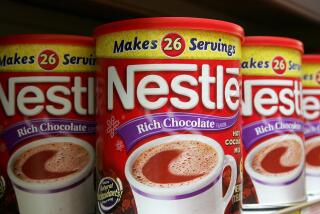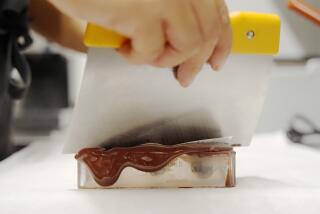HEALTHWATCH : Love of Chocolate : Valentine’s Day means it’s time to consider the pros and cons of consuming cocoa-based sweets.
- Share via
Like all good holidays, Valentine’s Day revolves around affection--make that confection.
Oh, there’s that love thing, too, but that’s secondary. What’s most important is the chocolate that represents those romantic feelings. Unfortunately, there’s a dark cloud in that silver wrapper. Not everyone thinks chocolate should supplant one of the four major food groups.
Just the mention of chocolate can spark debate. There are the straightforward arguments: “It tastes good” versus “It’ll give you cavities.” But the pros and cons go much further than that.
At the front line of the controversy is a chemical known as phenylethylamine, or PEA, which is found in cocoa from cocoa beans. It is said that when consumed, PEA has an effect on the involuntary nervous system, producing a sense of euphoria.
“It’s something very similar to feeling in love,” said Katalin Coburn, president of Jerbeau Chocolate Classics, a manufacturing company in Newbury Park. “It is a chemical found naturally in the brains of happy people. Anything that is pleasant will automatically produce PEA in one’s brain.”
Coburn said all forms of milk chocolate and dark chocolate have some PEA. The amount will vary depending on a manufacturer’s particular recipe.
Though many agree that chocolate can bring on a happier psychological state, studies have indicated that cocoa doesn’t contain enough PEA to have that effect. The average gram of chocolate contains only five micrograms of PEA.
Regardless, any “walking-on-air” feeling can be doused by the fear of weight gain from overconsumption of chocolate. For those who have been diligently keeping to their New Year’s diet resolutions, the abundance of chocolate on Valentine’s Day can pose a tough problem.
Consider these numbers, provided by east county dietitian Gwen Wareham, for a one-ounce piece of milk chocolate: 7 to 10 grams of fat, 150 calories, 54% of the calories coming from fat.
“The goal for the average American would be not to take in more than 50 grams of fat a day. For women it would actually be a little less, 30 to 40 grams,” Wareham said. “If you’re looking at food specifically for the amount of calories from fat, the goal is about 30%.”
As if diet wasn’t enough concern, most people probably have been loaded down with certain negative notions about chocolate. There’s the ever-popular chocolate-cavity connection, for one. The question is, is chocolate the real culprit?
“It’s the sugar that’s the problem, not the cocoa,” Ventura dentist James Hough said. “I think chocolate is fine as long as it’s eaten in moderation and people brush their teeth.”
Hough said that bacteria--plaque in this case--feed on the white refined sugar found in most candies. “Bacteria eat the sugar for energy for their little bodies,” he said. “They change the molecule to an acid molecule. That’s the waste product that they dump out of their bodies onto the teeth.”
Joseph Beierle, another local dentist, said chocolate doesn’t necessarily cause gum disease, but it can cause tooth decay. “I’ve seen too many times where it’s caused some whopper cavities,” he said.
On a more pleasant note, Beierle did bring up the “good chocolate” theory that has been circulating for several years. “There may be something in cocoa,” he said, “that can inhibit tooth decay.”
Unfortunately, for those on the pro-chocolate end of the debate, Beierle said, there is no good statistical evidence to support this theory.


